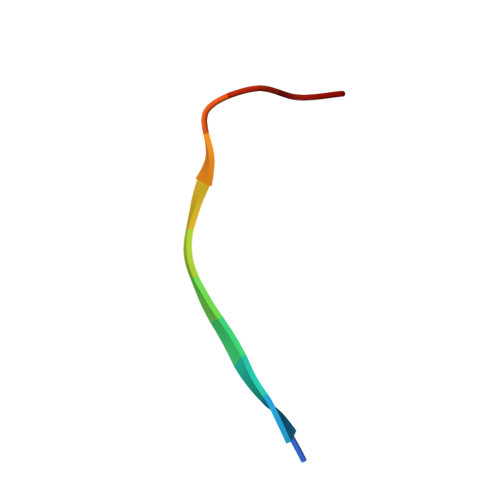Amyloid Oligomers: Expediting Crystal Growth and Revisiting the Corkscrew Structures.
Hirschbeck, S.S., Sawaya, M.R., Lindberg, E.T., Limbach, M.N., Jang, J.H., Lazar Cantrell, K.L., Eisenberg, D.S., Do, T.D.(2025) J Am Chem Soc 147: 18594-18605
- PubMed: 40398050
- DOI: https://doi.org/10.1021/jacs.5c00656
- Primary Citation of Related Structures:
9MIL - PubMed Abstract:
Crystallizing soluble amyloid oligomers (AOs) presents a major challenge in studying disease-related mutations associated with amyloid diseases. The G37R mutation in superoxide dismutase 1 (SOD1) is linked to early onset amyotrophic lateral sclerosis (ALS), yet its toxic mechanism remains unclear. The transient nature and low solubility of AOs often complicate the production of high-quality crystals required for X-ray crystallography (XRC) analysis. To address these challenges, we employ native ion mobility spectrometry-mass spectrometry (IMS-MS) to screen SOD1 peptides and examine correlations between structural features that reflect AO stability, their sequence length, and specific mutations. In particular, previous studies showed that the P28K mutation in SOD1(28-38) enhances solubility, thus allowing the capture of AO corkscrew structures for both SOD1(28-38) P28K and SOD1(28-38) P28K, G37R . Building on these findings, we expanded our screening to include SOD1 peptides with longer sequences, identifying structural features in IMS-MS spectra that correlate with improved crystallization potential. This approach enabled us to distinguish the stabilizing effects of G37R from those of P28K, culminating in the successful determination of the first crystal structure of the SOD1 corkscrew containing the native proline.
- Department of Chemistry, University of Tennessee, Knoxville, Tennessee 37996, United States.
Organizational Affiliation:



















